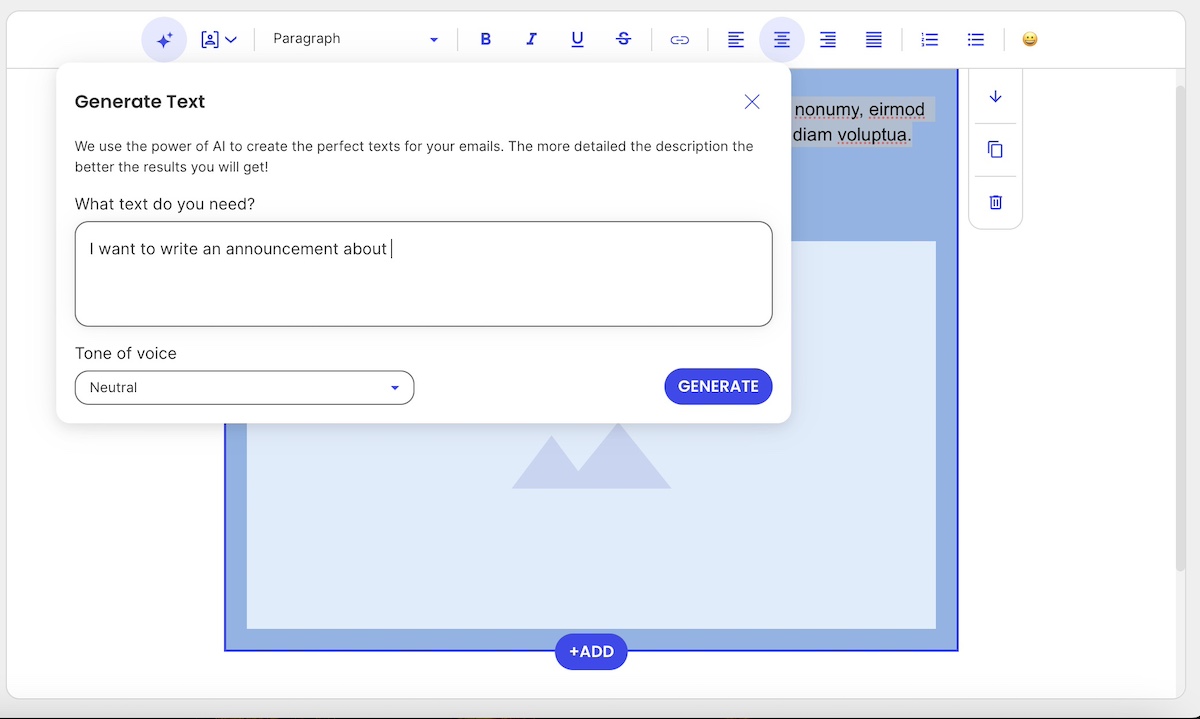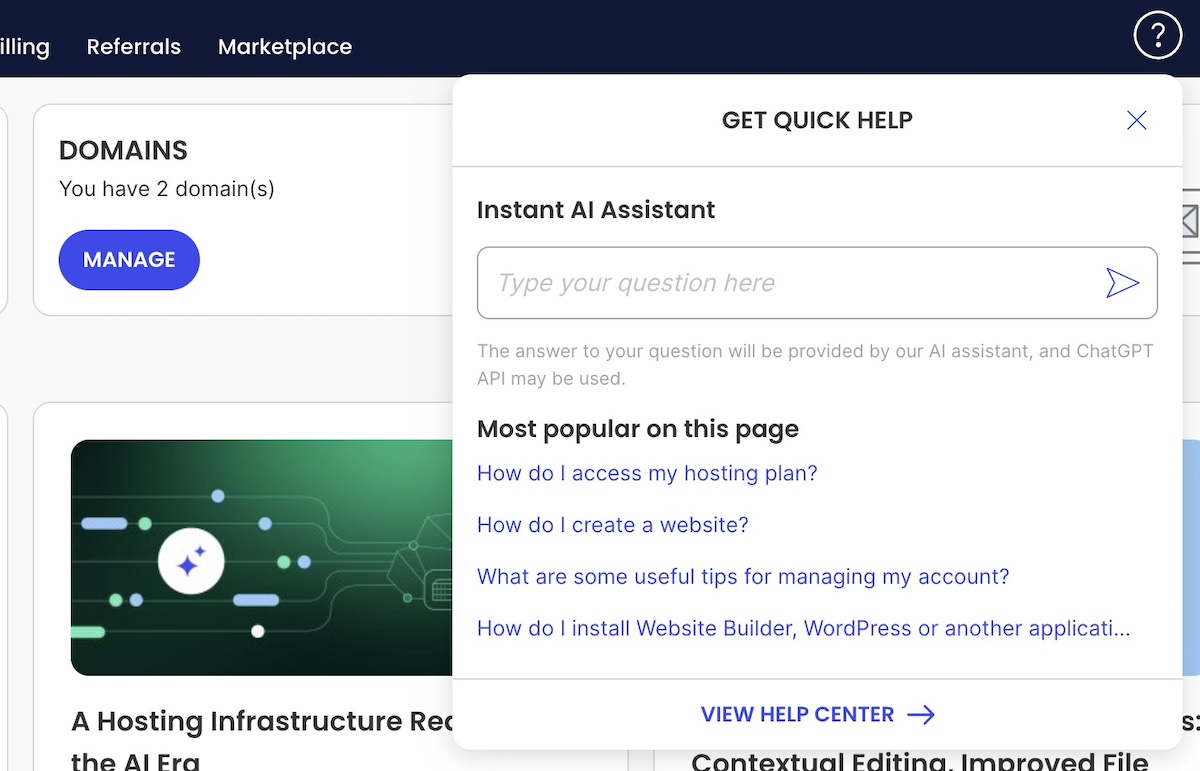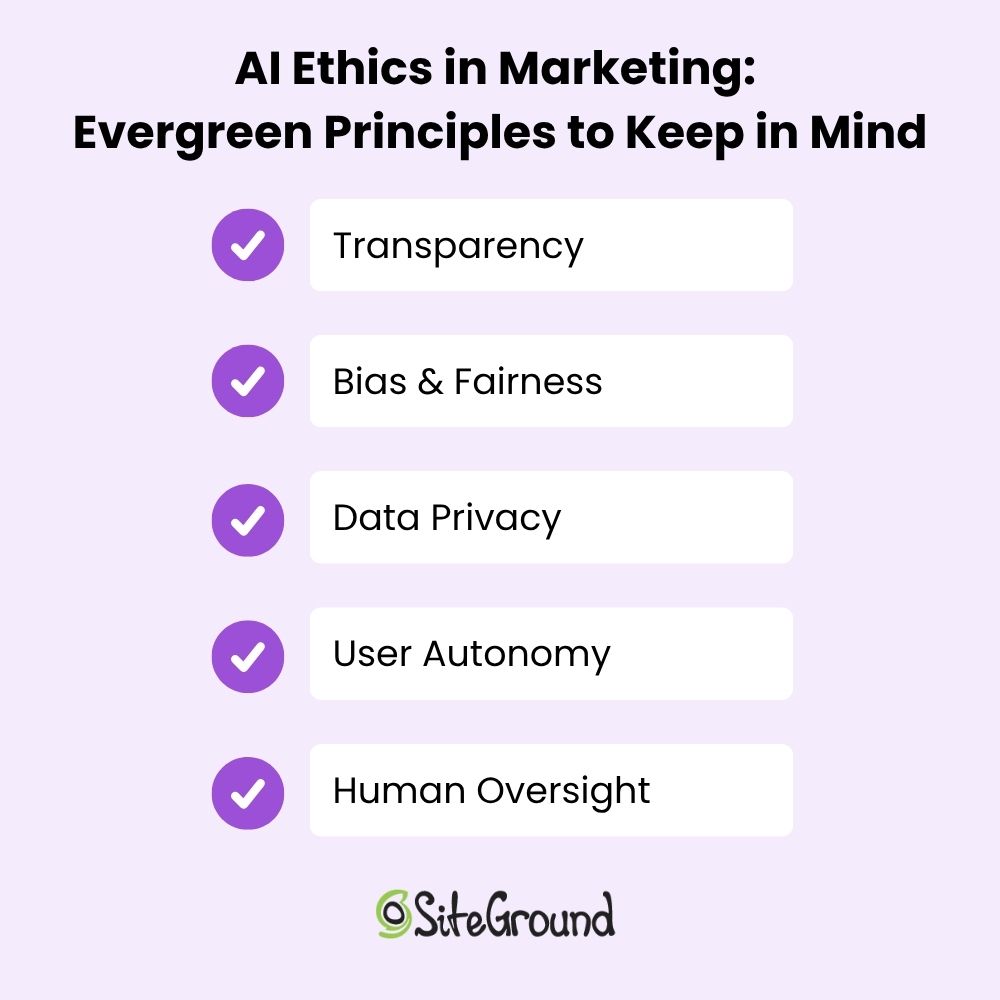AI Ethics in Marketing: What It Really Means in Practice

AI is now officially baked into our daily lives—whether we’re getting eerily accurate product suggestions, binge-worthy content queues, or always-available customer support. And if you’re in marketing, chances are you’re using AI tools more and more to get your job done. In many ways it’s great news, but as AI becomes a bigger part of our workflow and strategy, so does the looming question: What are the ethical considerations of AI in marketing?
So today we’re going to tackle what this means for your marketing in practical terms, and not just in philosophical ones. From chatbots to ChatGPT, we’ll be examining how you should be thinking about the ethics of AI in your day-to-day marketing and business efforts.
What Is AI in Marketing, Really?
Search for “AI ethics in marketing” and you’ll find a lot of big ideas—data privacy, algorithmic bias, transparency—but not much clarity on what those issues actually look like in real life. Are we talking about the ethics of ad targeting? Of AI-generated content? Customer data? And which of these actually apply to your corner of the marketing world?
Indeed “AI in marketing” is a broad umbrella of considerations that includes everything from writing email subject lines to predicting who’s most likely to click “buy.” It can automate, analyze, personalize, and generate at a scale that wasn’t possible even a few years ago—transforming everything from campaign targeting to content creation, and even how AI shapes SEO strategy.
But not all AI tools carry the same issues and risks—or raise the same ethical questions.
To make this more actionable, we’re going to break these considerations down by use case and explore what to watch out for with each:
- Generative AI that creates text, images, or video
- Predictive analytics that forecast behavior and outcomes
- Personalization engines that tailor content or offers
- Chatbots and virtual assistants that manage interactions
- Ad targeting algorithms that decide who sees what
Each of these issues comes with its own set of implications and benefits—and its own ethical blind spots. So instead of talking ethics in the abstract, we’re going to look at these considerations in context.
Let’s get into it.
The Ethical Considerations of AI by Marketing Use Case
1. Generative AI & Content Creation
AI tools like ChatGPT, Jasper, or DALL·E have all become commonplace go-tos in any marketers toolbox. Product descriptions, blog posts, ad campaigns—they’re all fair game when it comes to AI-generated content. Which is also why it has a lot of marketers scratching their heads, wondering about the ethical considerations at play.

Key Concerns
- Transparency: When consumers take in content, they very likely assume it was created the old-fashioned way (by a human, that is!), and not by AI. This assumption can be problematic because it may mislead readers about the source or credibility of the information. For example:
- In educational or informational content, AI can easily present outdated or inaccurate facts with confident and not-so-transparent wording, which could misinform readers who trust it as expert insight.
- In thought leadership, audiences expect original ideas or firsthand experience—something AI, by nature, cannot provide.
- In customer support, using AI without disclosure can negatively impact trust if users discover they’re interacting with a bot, especially in sensitive or high-stakes scenarios.
In short, when using an AI tool or ChatGPT for marketing, the output may lead people to believe they’re hearing from a human—particularly an expert, authority, or representative. Customers make decisions based on that perceived authenticity, and if your content isn’t original, it can undermine trust.
- Information Security: Many marketers use AI tools by inputting customer details, drafts, or internal business info into platforms like ChatGPT. But unless you’re using an enterprise-level solution with strict privacy policies, that information could potentially be stored or used to train future models. This raises concerns about safeguarding proprietary content and protecting customer privacy—especially when using free or public AI tools.
- Plagiarism & Originality: Generative AI tools are trained on large datasets scraped from the internet. While they create “new” content, there’s always a risk of closely replicating existing work—potentially without proper attribution or awareness.
- Brand Authenticity: Content generated by AI can lack nuance, emotional depth, or contextual awareness—especially when used without human review. This can lead to tone-deaf messaging, inconsistencies in voice, or even reputational harm if the content misrepresents your values.
Recommendations:
- Clearly label AI-generated content when appropriate, especially in editorial or informational contexts.
- Be mindful of what you share: Avoid pasting sensitive, personal, or proprietary information into generative AI tools unless they’re designed for secure, enterprise use. Treat AI like an external collaborator—one who needs boundaries to protect your business and your customers.
- Be smart about your ChatGPT prompts, making sure they are extra precise in order to yield highly custom responses, then refine to really make the content your own.
- You’re the brain, AI is just the assistant: AI is a powerful creative partner, but it shouldn’t replace your own thinking. Use it to draft, brainstorm, or edit—but the final insight, perspective, and voice should come from you. That’s what keeps your content original, credible, and human.
- Use plagiarism checkers and editing tools to review AI output for originality and quality.
- Maintain human oversight to ensure the tone, message, and brand identity are preserved.
Pro tip: As AI content becomes more prevalent across blogs, landing pages, and campaign assets, a new consideration is emerging: how to ensure it gets found. This is where Generative Engine Optimization—or GEO—comes into play. GEO is about crafting AI-generated content that’s not just high-quality, but also structured and styled to perform well in AI-driven discovery tools like ChatGPT, Perplexity, and Google’s AI Overviews. It’s just another reason to make sure your content is original and worth discovering.
Get Your Free ChatGPT Prompt Formula Cheat Sheet Whether you’re new to AI or looking to refine your skills, start creating better prompts today!
Google reCAPTCHA used. Privacy Policy and Terms of Service apply![]()
2. Predictive Analytics
AI-driven predictive analytics allow marketers to identify trends, segment customers, and forecast behaviors—from churn risk to likelihood to purchase. It unlocks a whole lot of marketing potential! But when applied without care, it also raises ethical red flags.
Key Concerns:
- Data Privacy: Predictive models rely on vast amounts of behavioral and demographic data, a lot of which is collected passively or indirectly. So if customers aren’t aware of how their data is being used, or didn’t explicitly consent, you as the marketer risk violating privacy norms or even regulations.
- Bias: If the training data reflects real-world inequalities, the model can reproduce and reinforce them. For example, a model predicting “high-value customers” could unintentionally prioritize certain age groups, zip codes, or socioeconomic classes, leading to exclusion or discrimination.
- Over-targeting: Just because you can anticipate a customer’s behavior doesn’t mean you should act on it. Hyper-personalized targeting can cross the line into manipulation, nudging users in ways that feel intrusive or exploit emotional vulnerabilities (like targeting someone during a late-night scroll binge).
Recommendations:
- Be clear about consent: Ensure that data used in predictive models is collected ethically and transparently. Revisit your privacy policies to make sure they align with how you actually use data.
- Test for fairness: Regularly audit models for biased outcomes. This means checking whether certain groups are being unfairly excluded or overly targeted—and adjusting the model or dataset accordingly.
- Use data to empower, not pressure: Aim to support customer decisions, not manipulate them. For instance, predictive models can be used to help users find what they need faster—not to push unnecessary purchases or create urgency traps.
- Involve cross-functional review: Bring in legal, compliance, and ethical oversight—especially for sensitive use cases—to ensure predictive tools are aligned with your company’s broader values and obligations.
3. Personalization Engines
Everyone loves a good recommendation—like a spot-on product pick or an ad that feels like it just read your mind. When personalization is done right, it can feel like magic. But there’s a fine line between helpful and just plain creepy.
Key Concerns:
- Manipulation: Personalization can quickly become persuasion. Nudging someone toward a product they might like is one thing, but designing experiences that subtly push them into spending more or clicking faster can feel exploitative, especially if emotional triggers are involved.
- Fairness: Algorithms often determine who sees what, but not everyone gets the same deals, opportunities, or exposure. We’ve touched on this already, but if your system unintentionally favors certain demographics or behaviors—like showing premium products only to high-income areas or reinforcing gender stereotypes in recommendations—you might be leaving others out without realizing it. And that’s just not good business.
- Data Transparency: People should know how and why they’re seeing certain content. If your site feels like it knows too much without ever asking, it can set off privacy alarms.
Recommendations:
- Be helpful, not pushy: Use personalization to guide, not pressure. That means going with: “Here’s what we think you’ll love,” instead of “Buy this now or miss out forever.”
- Audit for fairness: Check who’s getting shown what, and who’s not. Test across different personas to make sure your engine isn’t creating a digital popularity contest.
- Explain the magic: A simple “We recommend this based on your recent views” goes a long way in making people feel informed, not tracked. Transparency builds trust and keeps the creep factor low.
4. Chatbots and Virtual Assistants
AI-powered chatbots and virtual assistants are everywhere—from answering FAQs to helping customers track orders or make product decisions. They’re efficient, available 24/7, and can handle a shocking number of queries without human help. But while they’ve come a long way, they still raise some eyebrows and come with their own set of implications.
Key Concerns:
- Disclosure: Users often assume they’re chatting with a human, especially when the bot is extra chatty or friendly, and introduces themselves by a name. So when you fail to make it clear that it’s an AI behind the screen, it can make the customer feel a bit duped (even more so if the conversation involves important or sensitive issues).
- Accuracy: Chatbots are only as smart as the data and rules behind them. They might give outdated or incomplete answers—or worse, confidently provide wrong information. When users rely on that info to make decisions, a simple mistake can have real consequences.
- The Empathy Gap: As hard as they try, Bots don’t have feelings, and yet they’re often used in situations that call for empathy, like complaints, cancellations, or product issues. So if a customer is frustrated or upset, a scripted bot response can feel cold or dismissive, damaging trust and sales instead of saving time and budget.
Recommendations:
- Be upfront about the bot: Start every interaction with a clear intro like, “Hi! I’m an AI assistant here to help.” This manages expectations and builds trust from the first message.
- Set smart limits: Know when to hand things off to a human. If a chatbot hits a complex or emotional issue, the best response might be, “Let me connect you to someone who can help further.”
- Train bots with care: Keep responses helpful, accurate, and human-sounding—but not too human. Also, regularly update content to make sure answers reflect current policies, inventory, or terms.
- Add emotional intelligence cues: Even if bots can’t feel, they can still respond in ways that feel thoughtful. Phrases like “I understand that must be frustrating” can go a long way in softening automated replies. And again, set those smart limits, so that if a customer is truly frustrated, they get connected with a real, feeling human being.

5. Ad Targeting Algorithms
AI-driven ad targeting is what makes those eerily relevant ads follow you around the internet—from the shoes you almost bought to the flight you only searched once, and the car you merely thought about researching when you saw it on the freeway yesterday. This kind of ad targeting is powerful, efficient, and often boosts ROI—but its creepy precision also raises some big questions about privacy, fairness, and how much users really know about what’s happening behind the scenes.
Key Concerns:
- Surveillance: We’ve all felt it: ad targeting can feel a lot like digital stalking. These algorithms track behavior across websites, apps, and devices, often collecting more data than users realize. And when people feel watched rather than understood, they start to get suspicious and trust a whole lot less.
- Algorithmic Bias: Bias strikes once again because AI learns from data patterns, but those patterns can reflect real-world inequalities. That means targeting algorithms might unintentionally exclude or stereotype certain groups—like showing job ads mostly to men or financial products only to wealthier users.
- Transparency: Most users don’t know why they’re seeing a certain ad, what data was used to target them, or how to control it. The more opaque the process, the more people feel manipulated instead of marketed to.
Recommendations:
- Collect responsibly: Be mindful of how much data you’re gathering and why. Stick to what’s needed, disclose it clearly, and give users real control over tracking and targeting preferences.
- Audit your targeting regularly: Like in other cases, check who your ads are reaching and, just as importantly, who they’re not. Make sure your campaigns aren’t unintentionally reinforcing bias or limiting reach.
- Offer transparency tools: Give users a way to understand and manage their ad experience (like “Why am I seeing this?” links or personalized ad settings). It’s good ethics and good UX.
- Balance relevance with respect: Smart targeting doesn’t have to feel invasive. Focus on delivering value, not just visibility. If your ad makes someone feel seen—in a good way—you’ve nailed it.
AI Ethics in Marketing: Evergreen Principles to Keep in Mind
As we’ve seen across different AI tools—from content generators to chatbots and ad engines—the ethical concerns and considerations may vary in detail, but they revolve around a few core themes. So as you move through the world of AI in marketing, no matter the context, you’ll always want to keep the following in mind:
Transparency
Whether it’s content, conversations, or ads, people deserve to know what’s AI-generated and how their data is being used. The more open you are, the more trust you earn.
Bias & Fairness
AI doesn’t operate in a vacuum. It learns from us, flaws and all. That means unchecked models can reinforce stereotypes or unfairly exclude certain groups. Ethical marketing means that businesses should actively work to catch and correct those patterns.
Data Privacy
Just because data is accessible doesn’t mean it should be used indiscriminately. Ethical AI marketing respects customer privacy—not only to comply with regulations like GDPR, CCPA, or other regional laws, but also to limit exposure of private data when using external AI tools. Transparent data practices and secure handling are non-negotiable pillars of trust.
User Autonomy
Personalization and prediction should empower users and not manipulate them. Ethical AI marketing supports better decision-making rather than pushing people into a corner.
Human Oversight
AI can do a lot, but it shouldn’t be doing it all alone. Keeping humans in the loop—especially for sensitive decisions or customer touchpoints—is what makes AI feel like a tool, not a replacement. It’s not meant to be the brain—it’s there to assist your brain. Your ideas, your judgment, and your expertise are still the most valuable parts of the process.
Together, these considerations form the foundation of responsible AI marketing and business. They’re not just “nice-to-haves,” but in fact critical for building brands that last.

Ethical Implications of AI: Where Marketers Go From Here
AI isn’t going anywhere—and neither are the ethical questions and implications that come with it. As marketers, we’re in a powerful position, as we get to shape how AI shows up in the world, how it interacts with real people, and how much trust it earns (or loses) in the process. That means asking hard questions, pushing for transparency, and making ethics an integral part of the process from the start.
We at SiteGround lean into AI, and it’s thoughtfully weaved into the fabric of what we do. For web hosting, our Antibot AI blocks millions of brute-force attacks before they ever reach your site. When it comes to finding the perfect domain, AI powers our search tools to suggest names that are relevant, memorable, and on-brand. And when it’s time to build your website or craft your next campaign, our Website Builder and Email Marketing Platform include built-in AI tools to help you create fresh content that’s clear, polished, and ready to go.




Comments ( 0 )
Thanks! Your comment will be held for moderation and will be shortly published, if it is related to this blog article. Comments for support inquiries or issues will not be published, if you have such please report it through our official channels of communication.
Leave a comment
Thanks! Your comment will be held for moderation and will be shortly published, if it is related to this blog article. Comments for support inquiries or issues will not be published, if you have such please report it through our official channels of communication.